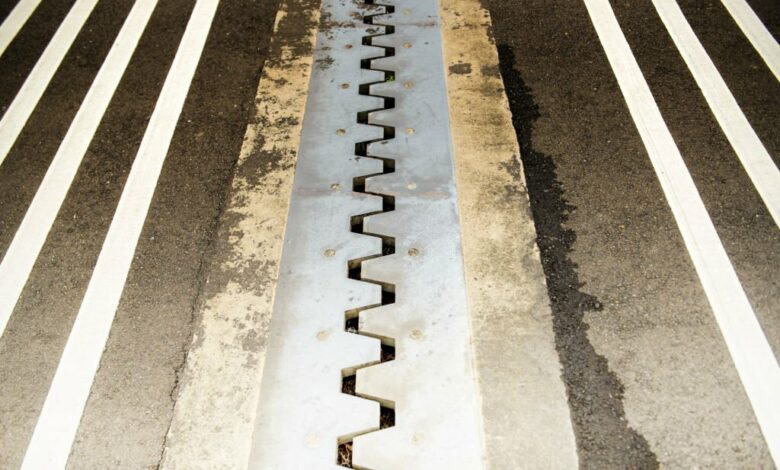

On a rainy day, you’re driving slowly and carefully toward your destination. As you approach the famous bridge and cross it, a horrible event occurs: the bridge starts to collapse behind you. The strange sound of breaking concrete and metal fills the air, crushing many cars. Shaken but safe, you return home to tell your family what happened. You say, ‘The bridge collapsed near our home; this wouldn’t have happened if the bridge had expansion joints.’ But your brother disagrees. He says, ‘No, fixed joints would have prevented this disaster.’ This makes you wonder, which is better for bridges: expansion joints or fixed joints?
In this write-up, we’ll examine the dynamics of expansion joints for bridges, weighing them against fixed joints to decide which is the better option.
Role of Expansion Joints for Bridges
An expansion joint is a carefully designed gap within a structure that allows for controlled movement, typically due to thermal expansion and contraction.
- Adjusting to Temperature Changes: Expansion joints in bridges are designed to adjust temperature-induced expansion and contraction. As temperatures fluctuate, materials expand, and contract, and they allow the bridge structure to flex without causing damage.
- Reducing Strain on Infrastructure: Bridges bear dynamic loads from vehicles and external forces. These joints absorb these loads, lowering stress on the bridge structure. This feature is particularly important in areas with severe temperature variations.
- Avoiding Cracks and Deformations: Fixed structures may develop cracks or distortions due to temperature changes. They act as protectors, preventing such issues by allowing controlled movement that adapts to thermal deviations.
- Improving Safety and Convenience: They contribute to the safety and comfort of bridge users. Adjusting movement reduces vibrations and the likelihood of structural damage, creating a smoother and safer experience for drivers and pedestrians.
The Role of Fixed Joints
A fixed joint is a connection between two structural components that does not allow for relative movement between them.
- Offering Strength and Support: They offer resilience and support to bridge structures. They are rigid connections that don’t allow movement, providing a stable foundation for bridge sections. This toughness can be beneficial in certain design scenarios.
- Streamlining Design and Building Process: They facilitate the design and construction process by eradicating the need to accommodate movement. They offer a straightforward solution for bridges with shorter spans or in areas with less temperature instability.
- Minimizing Maintenance: They generally demand less maintenance than expansion joints. Their sturdy construction undervalues the need for regular inspections and adjustments, making them a suitable choice for bridges where simplicity and durability are priorities.
Expansion Joints vs. Fixed Joints
1. Flexibility vs. Stability
- Expansion Joints: Provide flexibility, allowing controlled movement. Perfect for bridges in areas with substantial temperature deviations.
- Fixed Joints: Offer stability and rigorous support. Suited for bridges with shorter spans or in areas with less thermal instability.
2. Maintenance for Upkeep
- Expansion Joints: These may need more frequent inspections and maintenance due to moving parts. Crucial for ensuring continued effectiveness.
- Fixed Joints: Generally require minor maintenance due to their rigid and stable nature. Suitable for bridges in low-maintenance scenarios.
3. Financial Considerations
- Expansion Joints: Initial installation and maintenance costs may be higher due to the sophistication of the design and moving parts.
- Fixed Joints: Tend to be more affordable for installation and long-term maintenance.
4. Safety and Comfort
- Expansion Joints: Improve safety and comfort by absorbing dynamic loads and decreasing vibrations. Excellent for providing a smoother experience for bridge users.
- Fixed Joints: Offer stability but may transmit more forces to the structure, potentially affecting comfort and safety.
Selecting the Appropriate Option
When choosing between expansion joints and fixed joints for bridges, consider the following factors to make sure the right solution is for your specific needs:
- Evaluate Geographic Area: Expansion Joints are recommended for bridges in areas with considerable temperature fluctuations. Meanwhile, fixed joints are appropriate for bridges in regions with milder temperature variations.
- Assess the Bridge Length and Structure: Expansion Joints are perfect for longer bridges where movement due to thermal expansion is more prominent. Meanwhile, fixed Joints are well-suited for shorter bridges or those with less complicated designs.
- Consider the Maintenance Resource: Expansion Joints are considered if resources are available for regular inspections and maintenance. Meanwhile, fixed joints suit scenarios where minimizing maintenance requirements is a priority.
What Are the Primary Factors That Necessitate the Use of Expansion Joints in Bridge Construction?
Expansion joints are essential in bridge construction primarily to accommodate thermal expansion and contraction caused by temperature fluctuations. Without these joints, the bridge structure would be prone to cracking and deformation as materials expand and contract with changing temperatures
How Do Expansion Joints Contribute to the Safety and Comfort of Bridge Users?
Expansion joints play a crucial role in enhancing the safety and comfort of bridge users by absorbing dynamic loads from vehicles and external forces. By allowing controlled movement, these joints minimize vibrations and reduce the likelihood of structural damage, resulting in a smoother and safer experience for drivers and pedestrians.
What Are the Advantages of Using Fixed Joints in Bridge Construction?
Fixed joints offer stability and rigidity to bridge structures, providing a solid foundation for bridge sections. They streamline the design and construction process by eliminating the need to accommodate movement, making them particularly suitable for bridges with shorter spans or in areas with less temperature instability.
How Do Maintenance Requirements Differ Between Expansion Joints and Fixed Joints?
Expansion joints typically require more frequent inspections and maintenance due to their moving parts, which are essential for ensuring continued effectiveness. On the other hand, fixed joints generally demand less maintenance due to their rigid and stable nature, making them suitable for bridges in low-maintenance scenarios.
What Factors Should Be Considered When Deciding Between Expansion Joints and Fixed Joints for a Bridge Project?
When deciding between expansion joints and fixed joints for a bridge project, it’s crucial to consider factors such as geographic location, bridge length, design complexity, and maintenance resources. Evaluating these factors will help ensure that the chosen option aligns with the specific requirements of the bridge and promotes its long-term durability and safety.
Pioneering Quality in Bridge Expansion Joints
Polycrafts Pvt Limited, operating under the brand name Flexo Guard, is a top-notch manufacturer of road safety equipment specializing in rubber expansion joints in Pakistan. Renowned for their commitment to quality, they employ modern technologies to produce exceptional products tailored to customer requirements. They offer a diverse range of expansion joints for bridges, railways, pipes, and masonry.
Explore their range of premium expansion joints. Contact Polycrafts today for reliable solutions that stand the test of time.
On the Whole
The selection between expansion joints and fixed joints for bridges depends on different factors, including geographic location, bridge length, design complexity, and maintenance considerations.
Understanding the specific requirements of the bridge, considering the environmental factors, and weighing the long-term maintenance implications are crucial in making an informed decision. Choosing between the stability of fixed joints and the flexibility of expansion joints will help to guarantee that bridges link communities and promote safe travel while withstanding the rigors of time and use. Let’s build bridges that withstand the challenges of tomorrow!
Make sure to explore the rest of the site for more Fascinating Blogs!
Also Read: What Are the Health Benefits of Using Slides for Kids in Pakistan?





